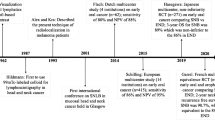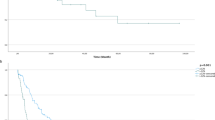Abstract
Background
To evaluate prognostic value of sentinel node biopsy (SNB) in oral/oropharyngeal squamous cell cancer (OOSCC) concerning overall/disease-free survival.
Methods
One hundred three consecutive patients with T1-2N0 OOSCC were consecutively recruited for SNB as single invasive staging method for the neck. Two hundred seventy-three sentinel nodes (SNs) were removed (mean, 2.65 per patient). Nine patients had 10 positive SNs (upstaging rate, 8.7%) found in levels I to III, leading to a therapeutic neck dissection.
Results
Mean observation time of all patients was 6.7 years; mean survival time of patients with negative or positive SNs was 6.9 and 3.7 years, respectively. There has been no false-negative result of SNB to date becoming manifest in ipsilateral node metastasis during follow-up. Five-year overall/disease-free survival of all patients was 82%/72%, respectively. The same parameters for the patients with negative SNs were 85%/74%, for those with positive SNs 38%/47%, respectively (statistically significant). There has been a higher statistical risk for locoregional recurrence for patients with positive SNs. Rates of metachronous second primary tumors developing during follow-up were 10.6% (negative SNs) and 44.4% (positive SNs).
Conclusion
SNB was a valuable diagnostic method in patients with T1-2N0 OOSCC avoiding elective neck dissections. Patients with positive SNs had statistically significantly higher rates of locoregional recurrences, second primary tumors, tumor-related deaths, and a worse overall/disease-free survival. To date, no therapeutic consequences in case of a positive SN beyond execution of modified radical neck dissection (to remove other positive nodes) and closer attention during follow-up can be concluded from this study.



Similar content being viewed by others
References
Ross GL, Soutar DS, Gordon MacDonald D, et al. Sentinel node biopsy in head and neck cancer: preliminary results of a multicenter trial. Ann Surg Oncol 2004;11:690–6.
Gershenwald JE, Thompson W, Mansfield PF, et al. Multi-institutional melanoma lymphatic mapping experience: the prognostic value of sentinel lymph node status in 612 stage I or II melanoma patients. J Clin Oncol 1999;17:976–83.
Morton DL, Thompson JF, Cochran AJ, et al. MSLT Group. Sentinel-node biopsy or nodal observation in melanoma. N Engl J Med 2006;355:1307–17.
Kuehn T, Bembenek A, Decker T, et al. Consensus Committee of the German Society of Senology. A concept for the clinical implementation of sentinel lymph node biopsy in patients with breast carcinoma with special regard to quality assurance. Cancer 2005;103:451–61.
Kovács AF, Acker P, Berner U, et al. Sentinel lymph node excision. Treatment method of the N0 neck in patients with oral and oropharyngeal carcinoma. HNO 2001;49:646–53
Kovács AF, Döbert N, Gaa J, et al. Positron emission tomography in combination with sentinel node biopsy reduces the rate of elective neck dissections in the treatment of oral and oropharyngeal cancer. J Clin Oncol 2004;22:3973–80.
Kovács AF, Landes CA, Hamscho N, et al. Sentinel node biopsy as staging tool in a multimodality treatment approach to cancer of the oral cavity and the oropharynx. Otolaryngol Head Neck Surg 2005;132:570–6.
Kaplan EL, Meier P. Nonparametric estimation from incomplete observations. J Am Stat Assoc 1958;53:457–81.
Kovács AF. Reply to Smith BD, Lally BE, Haffty BG, Wilson LD. Do PET and SNB reduce the rate of elective neck dissection? A hypothesis still in need of validation. J Clin Oncol 2005;23:2874–5
Gallegos-Hernández JF, Hernández-Hernández DM, Flores-Díaz R, et al. The number of sentinel nodes identified as prognostic factor in oral epidermoid cancer. Oral Oncol 2005;41:947–52.
Ionna F, Chiesa F, Longo F, et al. Prognostic value of sentinel node in oral cancer. Tumori 2002;88:18–9.
Hughes CJ, Gallo O, Spiro RH, et al. Management of occult neck metastases in oral cavity squamous carcinoma. Am J Surg 1993;166:380–3.
van den Brekel MW, van der Waal I, Meijer CJ, et al. The incidence of micrometastases in neck dissection specimens obtained from elective neck dissections. Laryngoscope 1996;106:987–91.
Werner J. [Sentinel lymphadenectomy as a staging procedure]. HNO 2005;53:511–2.
Civantos F Jr, Zitsch R, Bared A, et al. Sentinel node biopsy for squamous cell carcinoma of the head and neck. J Surg Oncol 2008;97:683–90.
Author information
Authors and Affiliations
Corresponding author
Rights and permissions
About this article
Cite this article
Kovács, A.F., Stefenelli, U., Seitz, O. et al. Positive Sentinel Lymph Nodes are a Negative Prognostic Factor for Survival in T1-2 Oral/Oropharyngeal Cancer—A Long-Term Study on 103 Patients. Ann Surg Oncol 16, 233–239 (2009). https://doi.org/10.1245/s10434-008-0150-5
Received:
Revised:
Accepted:
Published:
Issue Date:
DOI: https://doi.org/10.1245/s10434-008-0150-5




